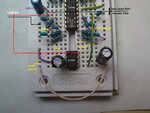KlausST
Advanced Member level 7
Hi,
Mathematically the half between two values is:
U_H = (U1 +U2) / 2.
Here U1 = +5V, U2 = -5V
U_H = (+5V + (-5V)) / 2 = (+5V -5V) / 2 = 0 / 2 = 0
Klaus
Mathematically the half between two values is:
U_H = (U1 +U2) / 2.
Here U1 = +5V, U2 = -5V
U_H = (+5V + (-5V)) / 2 = (+5V -5V) / 2 = 0 / 2 = 0
Klaus
